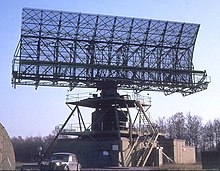 Global Information
Global InformationAMES Type 80 information
 The Type 80 radar at Metz in France run by the 61 AC&W Squadron of the Canadian 1st Air Division | |
| Country of origin | UK |
|---|---|
| Manufacturer | Decca |
| Introduced | 1954 |
| No. built | ~35 |
| Type | early warning, GCI |
| Frequency | S-band, 2.85 to 3.05 GHz |
| PRF | 235 to 300 pps, normally 250 to 270 pps |
| Beamwidth | 1⁄3º |
| Pulsewidth | 5 μS |
| RPM | 4 |
| Range | better than 240 nmi (440 km; 280 mi) |
| Diameter | 75 ft (23 m) |
| Azimuth | 360º |
| Elevation | 0–30º |
| Precision | 1 mile at 150 nmi |
| Power | 1 MW Mark I & II 2.5 MW Mark III |
| Other Names | Green Garlic AMES Type 81 |
The AMES Type 80, sometimes known by its development rainbow code Green Garlic,[1] was a powerful early warning (EW) and ground-controlled interception (GCI) radar developed by the Telecommunications Research Establishment (TRE) and built by Decca for the Royal Air Force (RAF). It could reliably detect a large fighter or small bomber at ranges over 210 nautical miles (390 km; 240 mi), and large, high-flying aircraft were seen out to the radar horizon. It was the primary military ground-based radar in the UK from the mid-1950s into the late 1960s, providing coverage over the entire British Isles.
In the late 1940s, the RAF developed the ROTOR plan to provide radar coverage over the UK in a phased rollout. As part of Stage 2, a new EW radar with long range would be deployed starting in 1957. A TRE research project, Green Garlic, appeared to be able to fill this role. The first examples of the Type 80 were being installed in 1953 and became operational in 1955. New sites received updated Mark III models and some formed the Master Radar Stations (MRS) that directly directed air defences, filling the GCI role as well. The original ROTOR plans for over 60 stations was reduced by half, retaining only a small number of older radars to fill gaps. Many of the ROTOR operations rooms, only recently completed, were sold off.
The system was developed during a period of rapid development in both radar technology and the nature of the strategic threat. The introduction of the hydrogen bomb led to serious questions about the nature of the defence, as a single bomber escaping interception was capable of causing catastrophic damage. Meanwhile, the introduction of the carcinotron radar jammer appeared to make such attacks much more likely to succeed. This led to plans to replace the Type 80s even before they were fully installed, relying on a much smaller network known as Linesman/Mediator with only three main sites. Two Type 80s were retained in this network for coverage over the North Sea, and several more were used for air traffic control.
Some of the Mark I models shut down as early as 1959 as the Mark III's increased range began filling gaps. Most of the UK fleet shut down in the late 1960s as Linesman's AMES Type 85s came online. The Type 80 also saw some overseas use by the RAF, with stations in Germany, Cyprus, Malta and Christmas Island. One was used by the Royal Canadian Air Force for operations around Metz. Four were used in Sweden. Potential sales for NADGE lost to a system from Thomson-CSF. The Swedish examples, Tom, Dick, Harry and Fred, were in use until 1978/79. The last Type 80, at RAF Buchan, shut down in 1993[a] after 37 years of operation. A total of about 35 Type 80s were built.
- ^ Gough 1993, p. 124.
- ^ Burr 2010.
Cite error: There are <ref group=lower-alpha> tags or {{efn}} templates on this page, but the references will not show without a {{reflist|group=lower-alpha}} template or {{notelist}} template (see the help page).